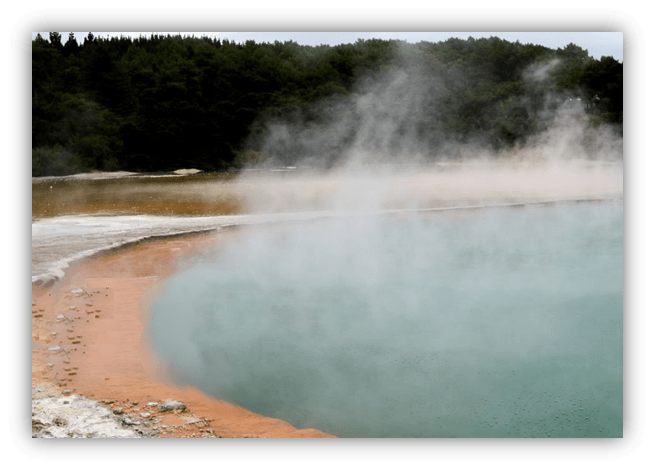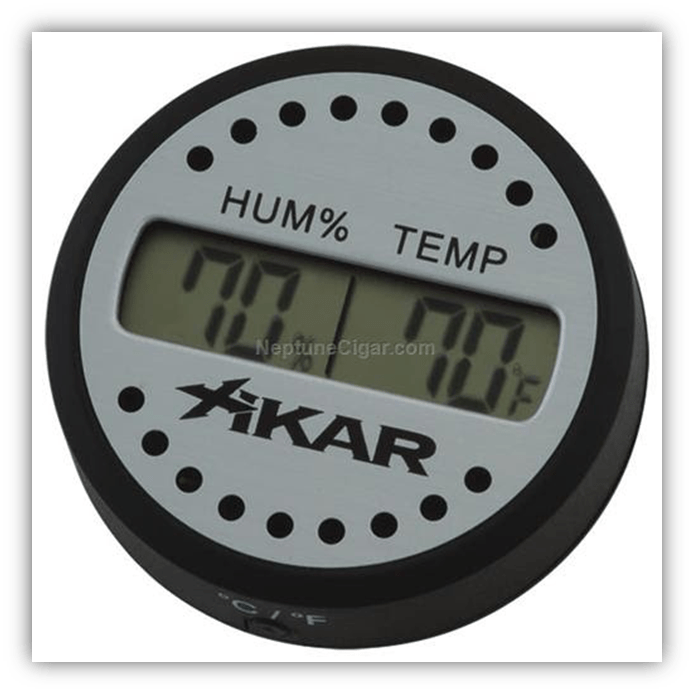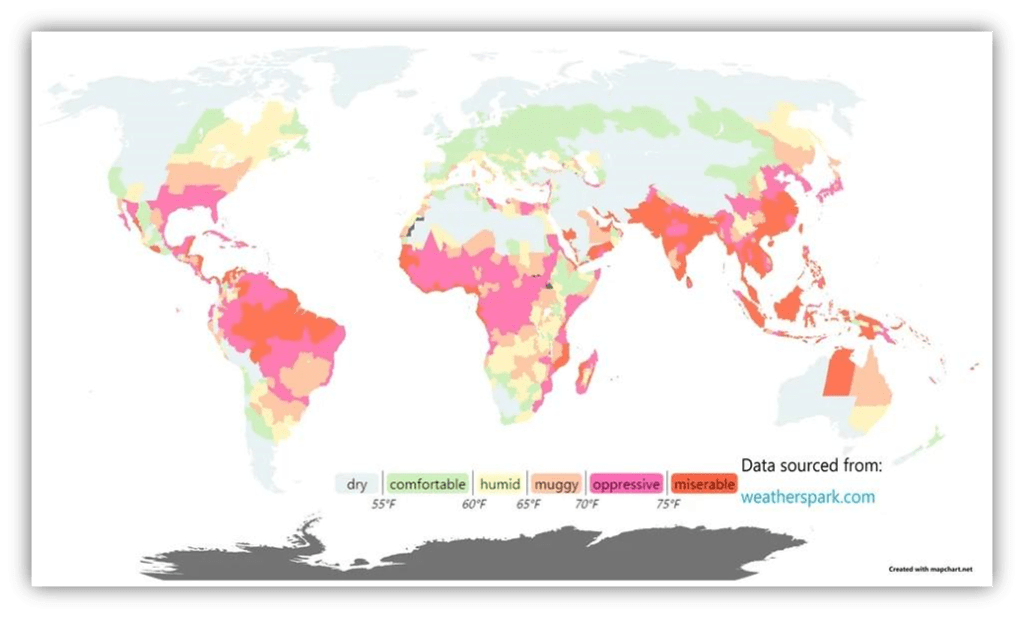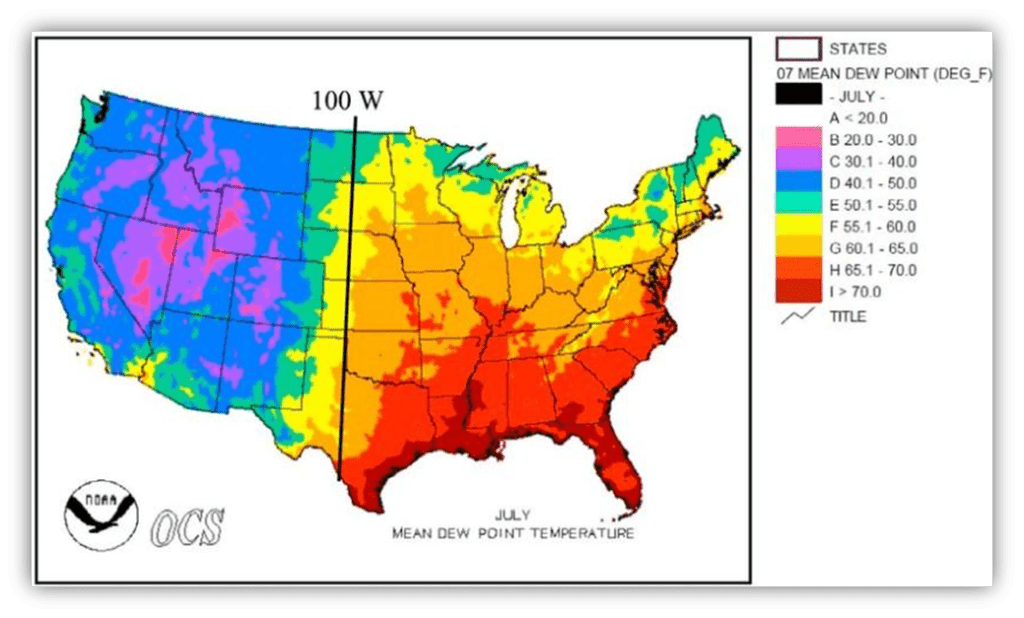Or: ‘How I Learned To Love Dew Point’
Muggy. Sticky. Steamy.
All summertime weather adjectives lamenting high humidity.

There are a few folks that freakishly seem to revel in these suffocating conditions.
But most “normal” people?

They would rather hunker down in an air conditioned shelter.
However you feel about it, one problem we frequently have is describing how humid the air is.
People usually describe how much moisture is in the air using the metric of Relative Humidity (RH).
RH is expressed as a percentage. It compares how much moisture is in the air with how much moisture there could possibly be in the air. That sounds easy enough…
But this measurement of humidity is relative.

“Relative to what?”
It’s relative to the temperature of the air.
Warm air can hold more moisture than cold air. For example, air at 104°F (40°C) can hold almost seven times more water vapor than air at 50°F (10°C).
The amount of moisture in air can change in several ways.

- Air can lose moisture when liquid condenses out of it in the form of cloud droplets or as dew.

- Air can gain moisture when liquid water evaporates into the air.
Additionally, the amount of moisture in the air can change as a cold front or warm front moves through, which essentially moves the old air out and brings new air in which has a different moisture content.
But on any given day, the amount of moisture in the air stays fairly constant.
It’s the temperature that changes. During the heat of a summer day the RH may only be 25%. As the temperature drops at night, the RH rises until it approaches 100%.

The amount of moisture in the air didn’t change, but since the temperature cooled overnight, the amount of moisture that the air is able to hold goes down.
Confused yet?
It is a little confusing. Which is why RH is a flawed metric.
I sometimes hear folks brag that they were outside on a humid day and that, “…the temperature was 100 – and so was the humidity!” That is virtually impossible outside of a controlled laboratory experiment.
I was recently at an outdoor concert in Washington DC.
It featured the K-pop band Stray Kids:

(My wife’s favorite group.)
During the concert the temperature was 99°F (37°C), and the RH was only 45%. The concert ended up being cancelled just before the encore. A number of audience members were fainting from heat exhaustion (I personally saw two different people pass out).
I think that the band was having trouble, too.
Its eight members and about 18 backup dancers had been laboring through nearly two hours of dance routines in the heat. It just became too much.

Nobody booed or complained. Everyone understood that the conditions were just too extreme.
So if RH is a confusing way to express moisture conditions, what can we do?
Well, meteorologists developed the heat index, which is kind of the opposite of wind chill.
It takes into account not just the temperature, but also the moisture in the air.

This is helpful, and is probably the best solution for those not meteorologically inclined.
During the Stray Kids concert the heat index was 118°F (48°C), which is treading into dangerous territory.
But let me suggest another metric: the Dew Point.
Dew Point is the temperature to which air needs to be cooled in order to produce dew…or in other words: 100% RH.
The nice thing about dew point is that it is independent of temperature. If the dew point is 68°F (20°C) during the day, it will probably be close to the same at night. AND, it is actually a pretty good indicator of how clammy you will feel on any given day.
Individual human comfort zones vary by what we are used to.
But generally, people feel comfortable at dew points lower than 60°F (about 15°C). As dew points rise through the 60s, the discomfort level rises.

Dewpoints in the 70s (about 21-26°C) are obnoxious, and almost universally disliked.
Occasionally, on our planet, dewpoints exceed 80°F (27°C).
80°F dew points aren’t unusual in equatorial locations near the ocean, but are rare in more temperate climate zones.
In the US, the highest dewpoints are usually associated with evapotranspiration in large areas of corn crops in the midwest.

Nicknamed “corn sweat:”
It’s why Iowa in the summertime may have the highest dew points in the US, despite it being so isolated from an ocean.
This world map below shows average dew point values.

Note how miserably humid areas of the Brazilian rain forest and southeastern Asia are. Areas further from the equator can experience equatorial-like dew points temporarily (during monsoons or individual storm systems) before returning to more normal conditions.
Below is a map of average dew point temperatures in July for the US.

The line of 100 West longitude is indicated, because this is around where the “dry line” normally lies. It separates the drier air of the intermountain west from the humid air from the Gulf of Mexico. (The dry line can become a meteorological feature that helps initiate thunderstorms on any given day during the warm season.)
The low dew points out west make it easy to understand how a 95°F (35°C) day in …

Reno, Nevada…

… is so much easier to tolerate than a 95°F (35°C) day in New Orleans.
It’s not even comparable in terms of personal comfort.
So as “they” say, it’s not so much the heat as it is the humidity.
And the best way to express it, especially in terms of summertime personal comfort, is with the dew point.
And now, because we like music here at tnocs.com…
It may surprise you to know that there are not a lot of songs about humidity and dew point. I do know of a couple.
- First, is a fantastically square song from Tom Glazer’s Weather Songs album: A children’s educational album from 1961.
Here’s “What Is Humidity”. (It’s only 1 minute long).
- Secondly, here is a song from The Great Weather Song Person called “Dew Point: What a Wonderful Thing!”
It is from “Meteorology Music For You To Like.” (Again, less than 2 minutes).
You’ve gotta like this guy’s enthusiasm!
- And finally, here is one of the Stray Kids’ most popular songs, “Chk Chk Boom”, recorded (not by me) at the Washington DC concert.
Can you imagine dancing in leather pants and long jackets in that heat? Everybody felt sorry for them.

Let the author know that you liked their article with a “Green Thumb” Upvote





Great article, Link — news you can use — and my hat’s off to you and Mrs. Crawford for enduring a concert in that much heat!
I’m listening to The Great Weather Song Person album, and it’s the most punk think I’ve heard in a while. Reminds me of Jonathan Richman. Great stuff!
Still not sure I understand dew point but I’ll read it another six times and see if I get it. While I stay inside with the A/C on.
Uh oh…maybe I wasn’t completely successful in my explanation. 🙁 It isn’t perfectly straight-forward.
It’s not you, it’s me.
(Something I’ve said at several key points in my life.)
A fine mix of educational and entertaining, thanks Link.
The worst heat I’ve experienced was in eSwatini though it was generally tolerable even though I was working outdoors. Looking at the dew point world map its classed as comfortable so that correlates. Though it is very close to a region marked as Oppressive. Which also correlates as there was one afternoon it was so bad the sun block I was trying to rub into my arms was running straight off in an unpleasant stream of sweat / sun block.
I have no idea what the relevant numbers were but my personal rating system put it at ‘what on earth are you doing working in this?!’
Based on that experience i can only applaud Stray Kids for their commitment.
No songs have reached the Hot 100 with “humid” in the title. One did chart with the word “dew”.
https://www.youtube.com/watch?v=GFLF2gdAwNE
This subject is more complex than it’s seems. In my country every discussion in social media is about “team hot” and “team cold”. The weather has changed a lot in the last few years, with periods of drought at least until last year, thank God it’s been raining a lot since a month and a half and the extreme hot is going away.